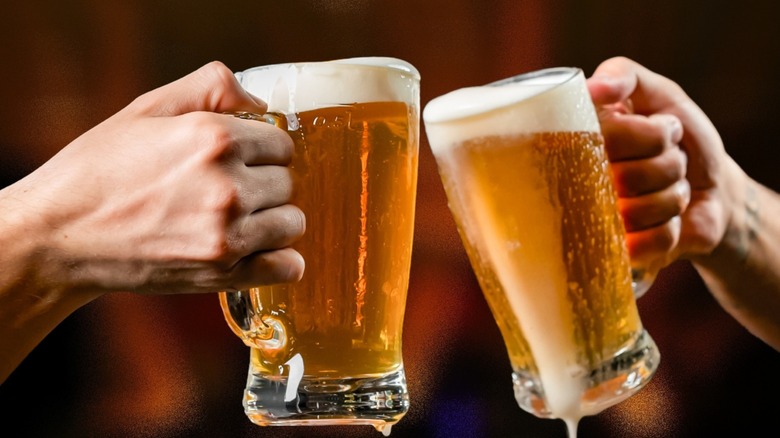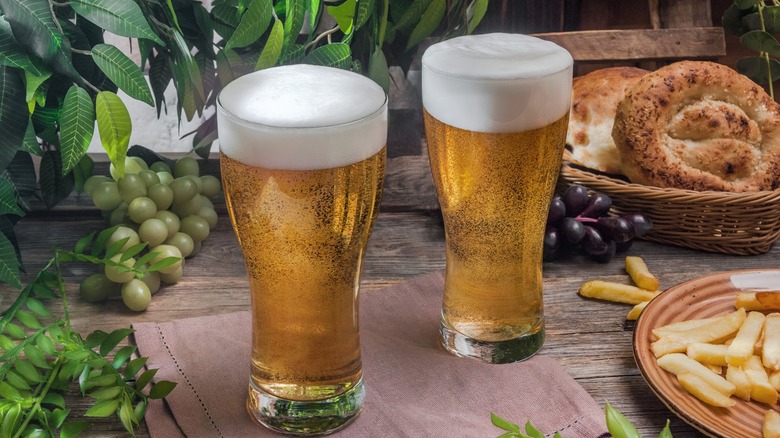Lager Vs Pilsner Beers: What's The Difference?
"Lager" and "pilsner" are two words you've probably heard when people are discussing different types of beer. To those entering the wide world of beers, and even to those who may consider themselves intermediate beer aficionados, all the different labels and names for various kinds of beer can be quite confusing — just look at the often-misunderstood difference between light and dark beer. Since beer's simple, probably accidental creation, the beverage has certainly sprouted many different branches, each one a little different than the other.
One thing muddies the water a bit here. For as prevalent as lagers and pilsners are in the beer market, the two aren't equal on the beer hierarchy. That is, while "lager" is indicative of a whole family of beers, "pilsner" represents one specific kind of beer within that same subset. So a pilsner is actually a type of lager, but even with this fact taken into consideration, there are still some differences between lagers (as a broad term) and pilsners specifically.
Lager is all about the fermentation process
A defining feature of lagers is the kind of yeast used in the beer's production. When making lager, producers typically use a type of yeast that ferments at colder temperatures, in the range of 44 to 55 degrees Fahrenheit, and gathers and ferments at the bottom of production tanks. In comparison, the other main type of yeast used in ales and other brews is top-fermenting yeast, which gathers and ferments at the top of the brew. In conjunction with this specific type of yeast, lagers were traditionally stored for a long period of time, which gives the yeast time to gather at the bottom, resulting in the distinctive clear brew. The term "lagering" itself comes from the German word "lagern" which means "to store" and refers to storing beer for a long period of time while it ferments. However, because lagering is used almost exclusively used when making bottom-fermented beers, the term eventually lent it's name to the family of beers in question.
Lagers are also typically identified by their color and taste. By virtue of lagers fermenting at lower temperatures relative to other beers, they tend to taste cleaner with fewer "funky" notes common in some other beer types. Their color also tends to be on the lighter side, though that isn't a hard-and-fast rule. As a result of their crisp taste, it's no surprise that lagers have dominated much of the beer market, with such behemoths as Budweiser, Coors, Corona, and Heineken all producing lagers. As for specific beer varieties that fall under the lager label, many helles, Märzens, dunkels, bocks, and Vienna-style beers can consider themselves cousins in the lager family.
A pilsner is a type of lager
Like lagers more broadly, pilsners are bottom-fermenting, cool-temperature beers. But pilsners still have some unique qualities that set them apart from other lagers. Specifically, they're exceptionally crisp and clean, both in look and in taste, and they tend to be a little hoppier than some other lagers. Hops are the ingredient that makes beer bitter, so you can expect pilsners to have just a tad more bite than some of its lager brethren.
For its easy-to-drink nature, pilsners are fairly common on the beer market. Some big names have their claim to fame wrapped up in pilsner production, such as Stella Artois, Carlsberg, Labatt Blue, and Bitburger — while the Czech-brewed Pilsner Urquell is often viewed as one of the premier pilsners with wide availability. And just as there are differences between pilsners and Kölsches, there can also be particular differences from one pilsner to the next, especially if you buy pilsners made in different regions. Ultimately, what you need to know is that all pilsners are lagers, but not all lagers are pilsners. And if you ever see both words written on the same label, now you know why.


